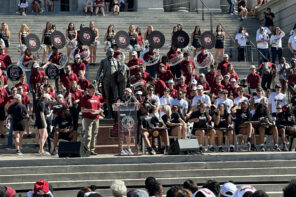It is not a well-kept secret that expansion remains one of the hottest topics amongst WNBA fans, primarily because of the allure of potentially introducing (or re-introducing) markets to the W.
Oakland appears to be the city that is putting a lot of money, time and resources into landing a WNBA expansion franchise. Other cities, such as Philadelphia and Nashville have also been rumored.
But WNBA commissioner Cathy Engelbert, per a much-ballyhooed New York Times article penned by the great Erica Ayala, all but put a temporary halt on any expansion plans that the WNBA may have now.
We’re going to absolutely expand down the road, but we don’t just expand for expansion’s sake until we get the economic model further along.
–Cathy Engelbert, WNBA commissioner (New York Times)
Cheryl Reeve, head coach and general manager of the Minnesota Lynx, was also quoted in that same article – and disagreed with Engelbert’s sentiments on expansion.
We need a greater commitment as a whole from the NBA and the NBA owners.
–Cheryl Reeve, coach and general manager, Minnesota Lynx
We need a greater commitment financially. We need greater investment. This league has been far too long about, you know, the revenues and expanses matching, don’t lose one dollar. And that’s not how you grow a league.
–Cheryl Reeve, coach and general manager, Minnesota Lynx
It is important to remember that Engelbert did not slam the door entirely shut on expansion. Apparently, she is privy to the conversations that have been taking place amongst the WNBA family as we all are.
But there is a downside to continuously delaying expansion as well.
When Lisa Borders was commissioner … er … “league president”, the expansion conversation was constantly brought up during her tenure as well. She constantly referred to wanting to ensure the existing 12 teams were financially healthy before expanding to new cities.
Of course, when Borders was commissioner, there was no COVID-19 pandemic – one that has cost many a WNBA and NBA owner lots of money. When thinking about WNBA and NBA expansion fees (obviously, those for an NBA team would be much higher than for a W team), expansion seems almost an instant way to recoup at least some of the money lost due to COVID.
While all has been silent on the expansion front lately within the WNBA/NBA ecosystem, one can still assume that the two likeliest cities to land NBA franchises will be Las Vegas and Seattle.
And while the WNBA can boast that it has more teams than Australia’s WNBL, which has eight, there is another women’s league that, despite all of its flaws, appears to be expanding at a breakneck pace.
That league is the NWSL and it too now stands at 12 teams. Also, the NWSL has not been around for nearly as long as the WNBA and for it to have the have the same number of teams while the W stays stationery at 12 has to raise at least some eyebrows.
Granted, that can get into a whole conversation about how big-pocketed sports owners feel more comfortable with investing in women’s soccer (because the faces of women’s soccer are white women) as opposed to the mostly Black and LGBTQ players that make up the WNBA. Megan Rapinoe once wrote about this in a 2020 article for The Players’ Tribune. But the facts are the facts.
The NWSL is by no means a perfect league – no league is and neither is the WNBA for that matter. As far as the NWSL goes, it goes without saying that it is not perfect given how 2021 was a season of scandal for that league. But how it has expanded in recent years to Louisville, Los Angeles and, most recently, San Diego ought to give plenty a WNBA executive pause as to how it can expand seemingly exponentially yet the W stays put at 12.
What the WNBA can also boast is how in recent seasons there has been a sense of stability starting to surround the league. The last time we saw a WNBA team move cities was prior to the 2018 season when the San Antonio Stars became the Las Vegas Aces. There are big-pocketed owners such as Mark Davis and Joe and Clara Wu Tsai (New York Liberty) that are seeing investing in WNBA teams as a worthwhile investment as opposed to the passing hobby that it was treated by previous W owners such as James Dolan.
Also, the Atlanta Dream recently underwent a sale to an investment group that includes Renee Montgomery, giving the Dream a chance to reset after being in the clutches of Mary Brock and Kelly Loeffler for so many years. In addition, the WNBA can take pride in that Marist poll cited by its own Jane McManus that says more watch the W than NASCAR.
While the Engelbert era has seen plenty of good for the WNBA – the addition of new sponsors and the convincing of the Davis’ and Tsais of the world to recognize the importance of women’s basketball, the expansion conversation is not going away anytime soon.
There is a reason as to why many a WNBA player pushes for expansion as well because they understand that bringing the world’s professional women’s basketball league to even more North American markets will help the league as a whole. They imagine the growth that the WNBA will encounter if the league were to expand to a market such as the Bay Area (Oakland) or Miami or a return to Houston or an expansion to Toronto.
As WNBA fans know, the growth potential in this league is enormous – it is simply a matter of those within the WNBA/NBA ecosystem to recognize it. Has the WNBA been its own worst enemy at times? Yes – its unwillingness to make every player jersey available is a reflection of this. But the players peep game.
After all, it was not that long ago that news broke where the NBA pledged to offer select contracts of $125,000 to top high school players. This was meant to be an alternative to what many premier high school prospects will do – go to college for one season then enter the NBA draft.
That number of $125,000 is very familiar to many a WNBA player – plenty of W contracts are worth around that very amount. In fact, before the CBA was signed in early 2020, that was more than the average max salary in the WNBA. So, one cannot blame players when they hear talk from WNBA executives about finances. The money is there – it simply needs to be placed in the right areas. Also, for all the flack the WNBA gets about its attendance issues, its attendance dwarfs that of many G-League teams.
Getting an even greater commitment from the NBA side of things is crucial to the W’s expansion prospects. And while it is admirable for the WNBA to be realistic about expansion, it has to strike the right chord between expanding responsibly and waiting too long to expand. The former may not be the right approach as it opens the possibility of teams being established too quick only for them to be mismanaged or sold off or moved too fast.
But the latter runs the risk of getting certain markets such as Oakland, Philadelphia and Nashville jazzed up about a WNBA team arriving in their cities only for expansion to become official after being teased time and time again.
The WNBA does not want to strike when the iron may be too cold. And, yes, it does want to get its financial ducks in a row. But Engelbert also needs to recognize it should not wait when that same iron gets white-hot only for it to cool off once again.




